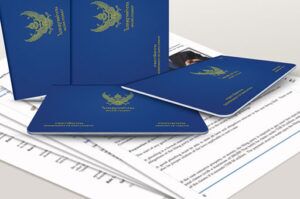Uniting with a loved one in the United States is a journey that many are hopeful for and are anticipating. For many Thai citizens, this begins with a critical decision: choosing the right visa, either K-1 or K-3 Visa.
The K-1 and K-3 visas emerge as popular paths for those with a fiancé(e) or spouse in the United States. Understanding the nuances of these visas, especially their processing times, is important for a smooth experience. This article delves into the details of the K-1 and K-3 visas, offering clear insights to help you make an informed decision. Whether you’re planning to marry or are already married to a US citizen, knowing which visa option can reunite you faster is essential. This article exists to guide you through each step, from application to arrival, ensuring you have the information needed for this important phase of your life.
K-1 Visa: For Fiancé(e)s of US Citizens
The K-1 visa, often known as the fiancé(e) visa, allows a Thai citizen engaged to a US citizen to enter the United States. The primary goal is to marry within 90 days of arrival. After the marriage, the Thai citizen can apply for permanent residency (a green card).
K-1 Visa Process
- Petition Submission: The US citizen files Form I-129F, Petition for Alien Fiancé(e), with US Citizenship and Immigration Services (USCIS).
- Approval and Forwarding: Once approved, USCIS sends the petition to the National Visa Center (NVC), which then forwards it to the US Embassy in Bangkok.
- Interview and Visa Issuance: The Thai citizen attends an interview at the embassy. If approved, they receive the K-1 visa.
Timeframe
The entire process typically takes about 7-10 months. However, this can vary based on individual circumstances and the current workload of USCIS and the U.S. Embassy.
K-3 Visa: For Spouses of US Citizens
The K-3 visa is for Thai citizens who are already married to US citizens. It’s designed to shorten the physical separation between the couple while the Thai spouse’s immigrant visa petition is being processed.
K-3 Visa Process
- Immigrant Visa Petition: The US citizen spouse files Form I-130, Petition for Alien Relative.
- K-3 Visa Petition: After filing Form I-130, the U.S. citizen can file Form I-129F for the K-3 visa.
- Approval and Interview: Once the K-3 visa petition is approved, it’s sent to the US Embassy in Bangkok. The Thai spouse then attends an interview for the visa.
Timeframe
The K-3 visa process can take about 8-12 months. However, with recent processing improvements for immigrant visas, the K-3 visa is becoming less common, as the wait time for the immigrant visa (green card) is often similar.
Which Is Faster?
When considering the speed of processing, the K-1 visa typically stands out as the faster option. This visa is tailored for fiancé(e)s, with a process that’s more direct and less complex. The US immigration system has streamlined the K-1 visa procedure, focusing on reuniting engaged couples swiftly. On the other hand, the K-3 visa, though designed as a quicker route for spouses, often doesn’t offer a significant time advantage. This is because the processing times for the immigrant visas, which spouses eventually need, have become more efficient in recent years. As a result, the time saved through the K-3 route is not as notable as it once was. In essence, while the K-3 visa remains a viable option for married couples, those looking for speed and efficiency in reuniting with their fiancé(e) in the US may find the K-1 visa to be a more suitable choice.
Other Considerations
- Marriage Plans: If you’re already married, the K-3 is your option. If you’re engaged, the K-1 is more suitable.
- Adjustment of Status: Post-marriage, K-1 visa holders must adjust their status to a permanent resident. This involves additional paperwork and time.
- Children: If children are involved, different forms and processes apply (K-2 for K-1, K-4 for K-3).
Financial Requirements and Evidence
A crucial aspect of both K-1 and K-3 visa applications is proving the financial stability of the US citizen sponsor. The sponsor must meet certain income requirements to ensure they can support their fiancé(e) or spouse.
- Affidavit of Support: For both visas, the US citizen must file an Affidavit of Support (Form I-134 for K-1, Form I-864 for K-3) demonstrating they have sufficient income or assets.
- Evidence: This includes tax returns, employment letters, and pay stubs. The income requirement is generally 125% of the Federal Poverty Guidelines.
Medical Examination and Vaccinations
Applicants for both K-1 and K-3 visas must undergo a medical examination by an approved physician. They also need to have certain vaccinations.
- Medical Examination: Includes a general physical check, chest X-ray, and blood tests.
- Vaccinations: Required vaccinations are listed by the U.S. Centers for Disease Control and Prevention (CDC).
Conclusion
In conclusion, the journey to reunite with a loved one in the United States is a path filled with decisions, of which choosing the right visa is paramount. While the K-1 visa generally offers a quicker route for fiancé(e)s, the decision between the K-1 and K-3 visas should be based on individual circumstances, including your current marital status and future plans. It’s essential to understand each visa’s requirements and prepare meticulously for the application process. Seeking professional advice can also play a significant role in navigating this journey smoothly. Remember, each couple’s story is unique, and the best choice depends on your specific situation. By making an informed decision, you can pave the way for a successful and timely reunion in the US, starting a new chapter of your life together with clarity and confidence.
Contact Siam Legal
 | Ken Graham US Immigration Attorney Partner, Siam Legal International |
 | Natdaphon Luengsawang Senior US Visa Consultant Siam Legal International |
LIVE SUPPORT
 CALLCall (702) 799 9719 |  CHATChat with our representative | |
| From US: Sunday – Friday 5:00 PM – 7:00 AM (New York time) 2:00 PM – 4:00 AM (Los Angeles time) From Thailand: Monday – Friday | ||








































